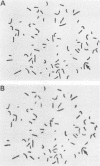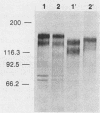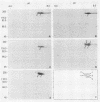Abstract
Expression of the epidermal growth factor (EGF) was analyzed in six human hepatocellular carcinoma-derived and one human hepatoblastoma-derived cell line, each of which retained the differentiated phenotype and functions of the parenchymal hepatocyte. The level of receptor expression of each hepatoma cell line was similar to that of the normal human fibroblast, approximately 10(5) molecules per cell. However, NPLC/PRF/5, a subline of the PLC/PRF/5 cell line obtained following reestablishment of a xenograft tumor in vitro, was found to express 4 x 10(6) high-affinity EGF receptor molecules per cell. Proliferation of the NPLC/PRF/5 cell line was inhibited in the presence of nanomolar quantities of ligand. Receptor overexpression was found to result from EGF receptor gene amplification without apparent rearrangement of the EGF receptor coding sequences. Although cell-specific variability in posttranslational processing of EGF receptor N-linked oligosaccharides in the hepatoma cell lines was found, no difference between the receptors in PLC/PRF/5 and NPLC/PRF/5 was observed and no aberrant receptor-related species were detected. EGF receptor gene amplification in the NPLC/PRF/5 cell line is probably a reflection of genome instability and selection of variants with augmented growth potential in limiting concentrations of EGF in vivo. When viewed in this light, EGF receptor overexpression could represent a manifestation of tumor progression in the EGF-responsive hepatocyte.
Full text
PDF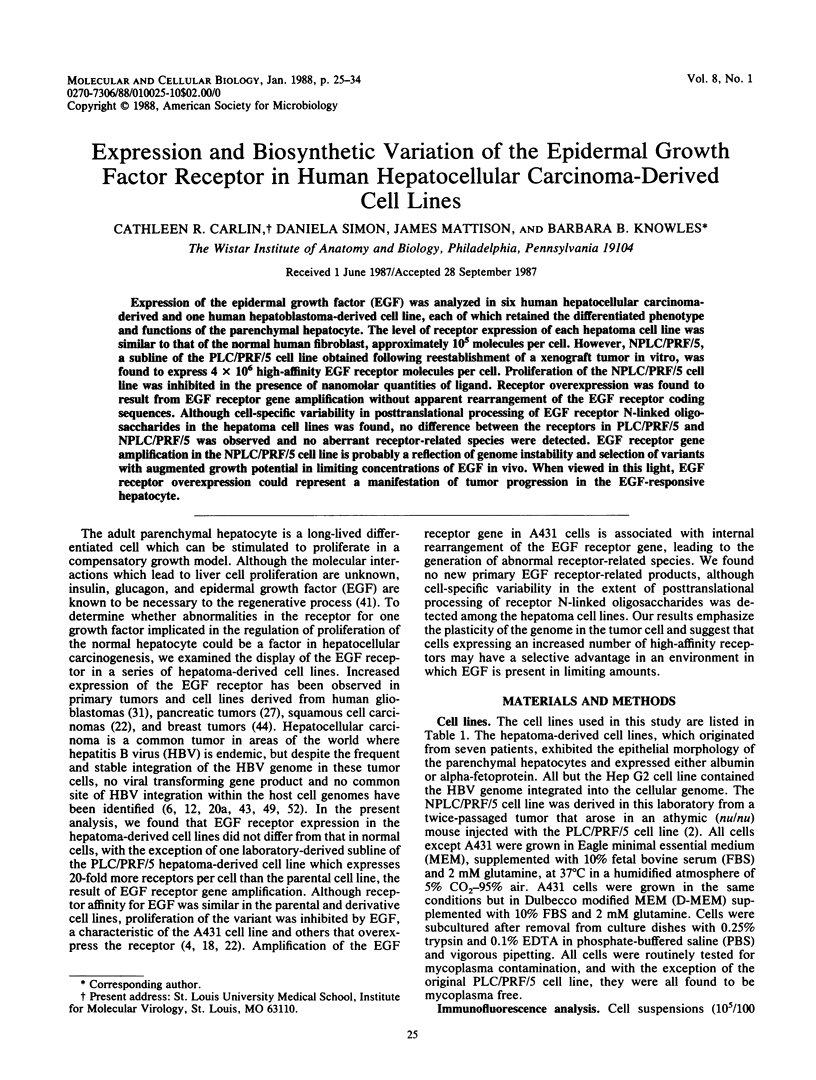
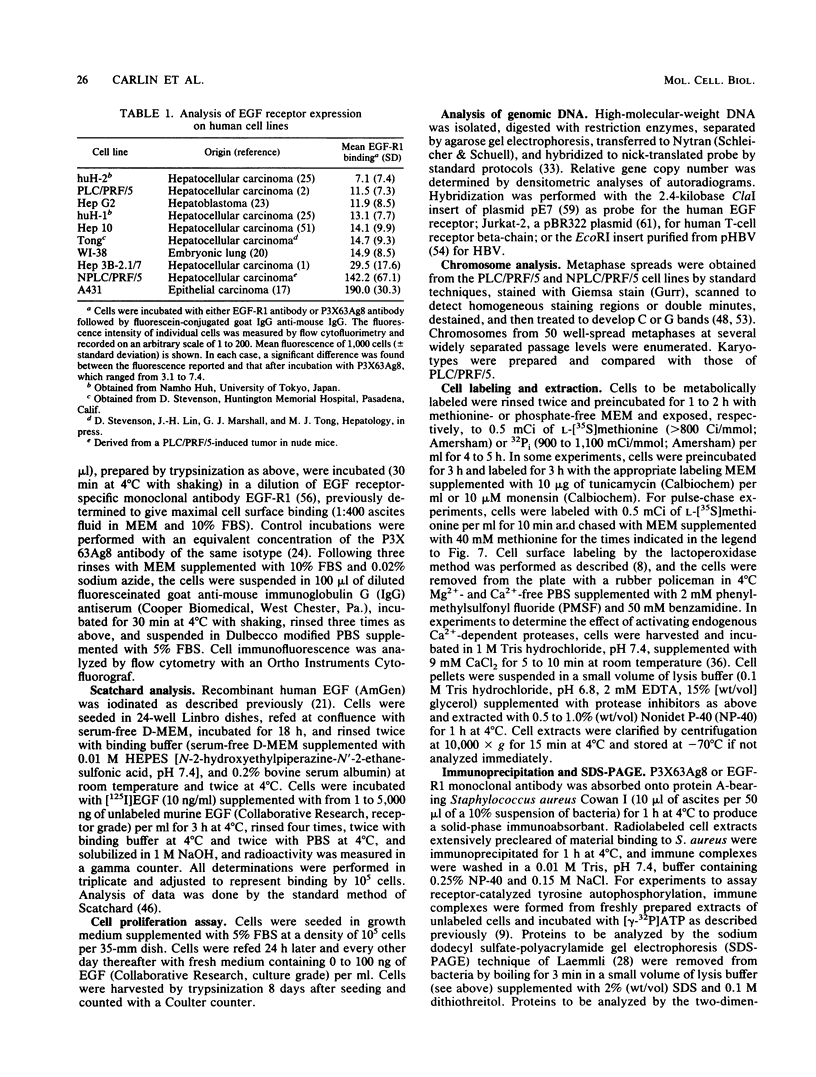
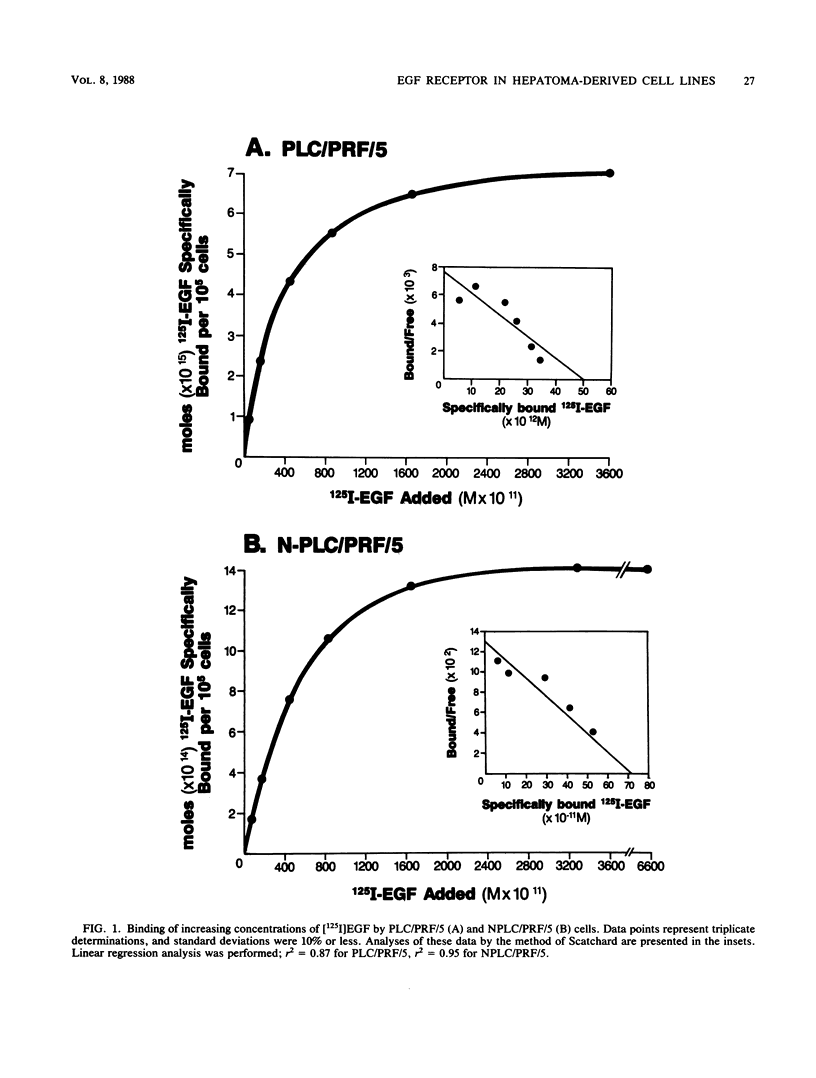
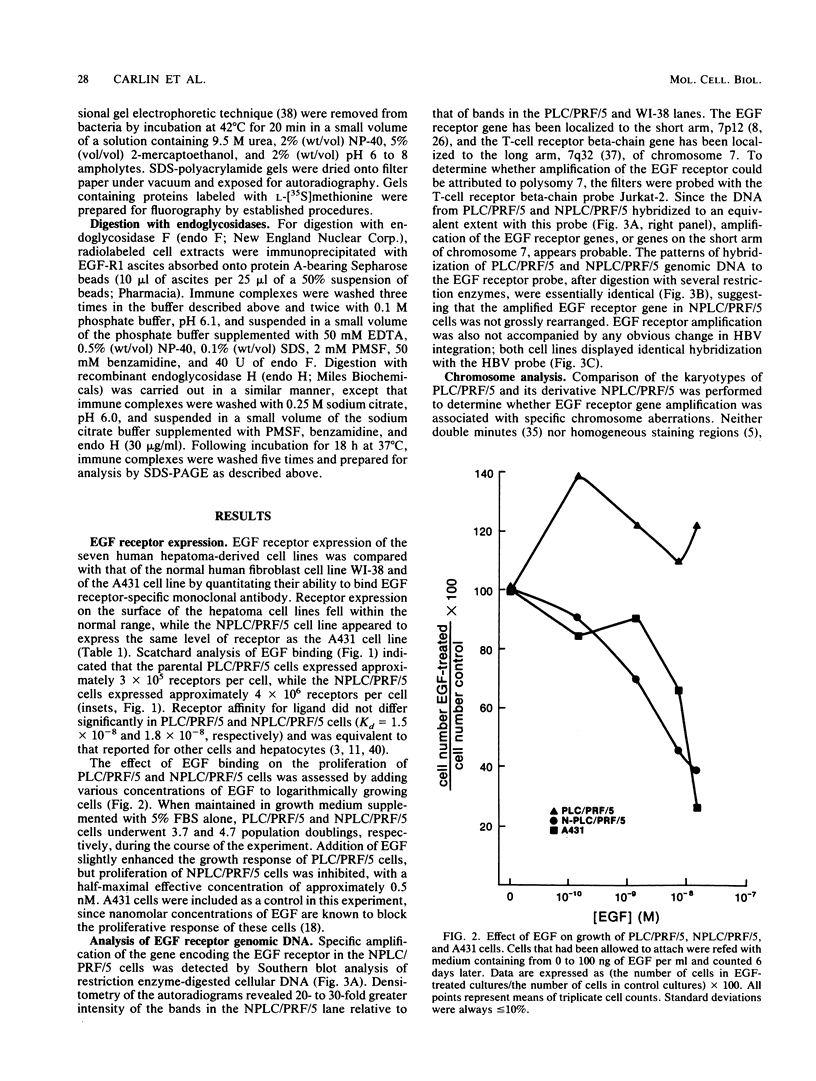
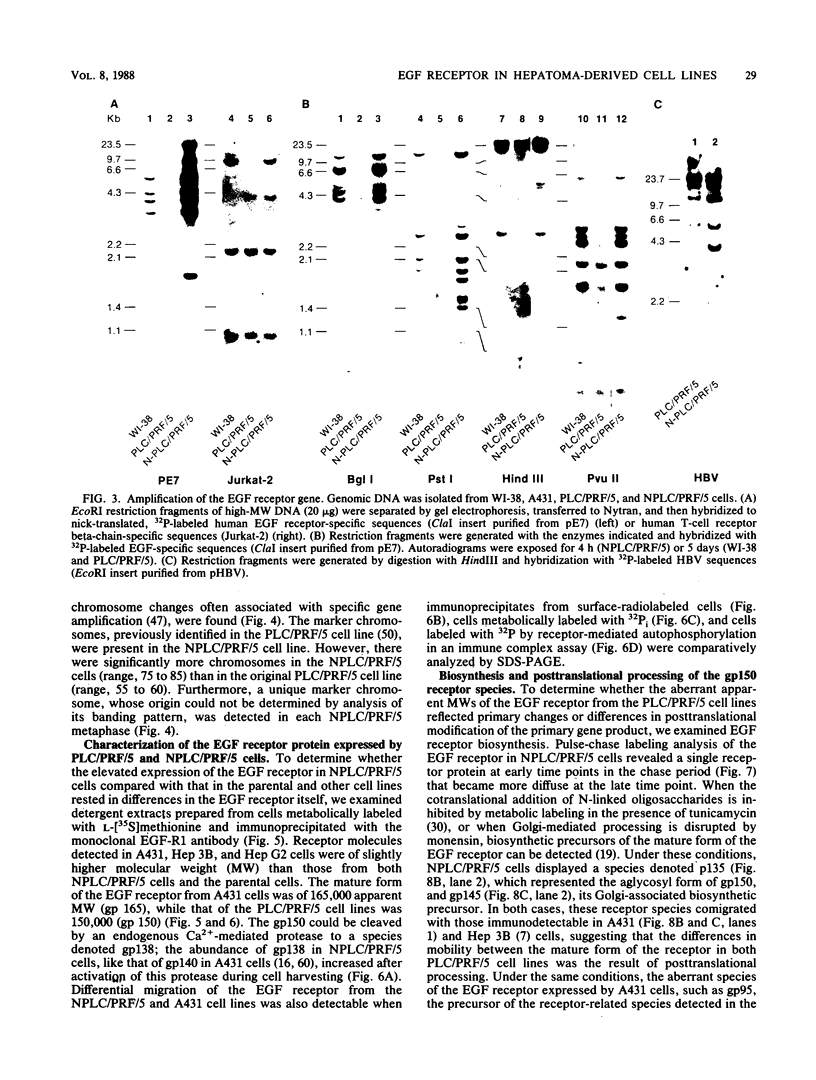
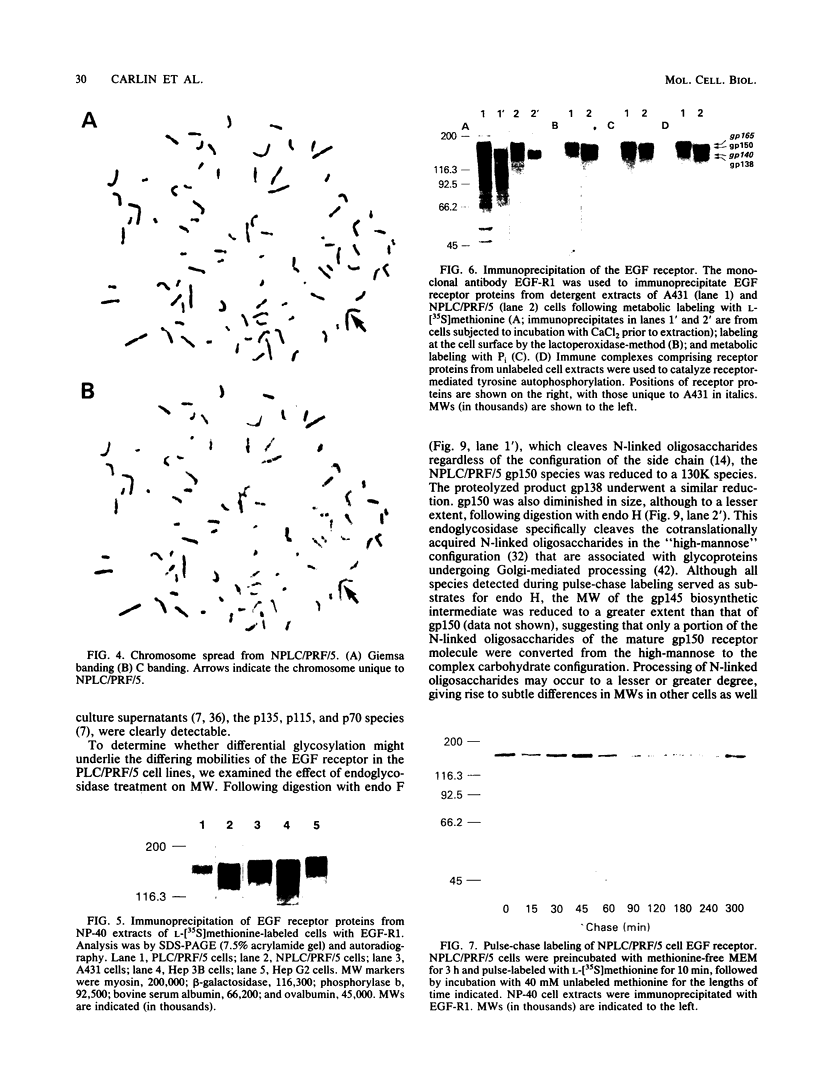
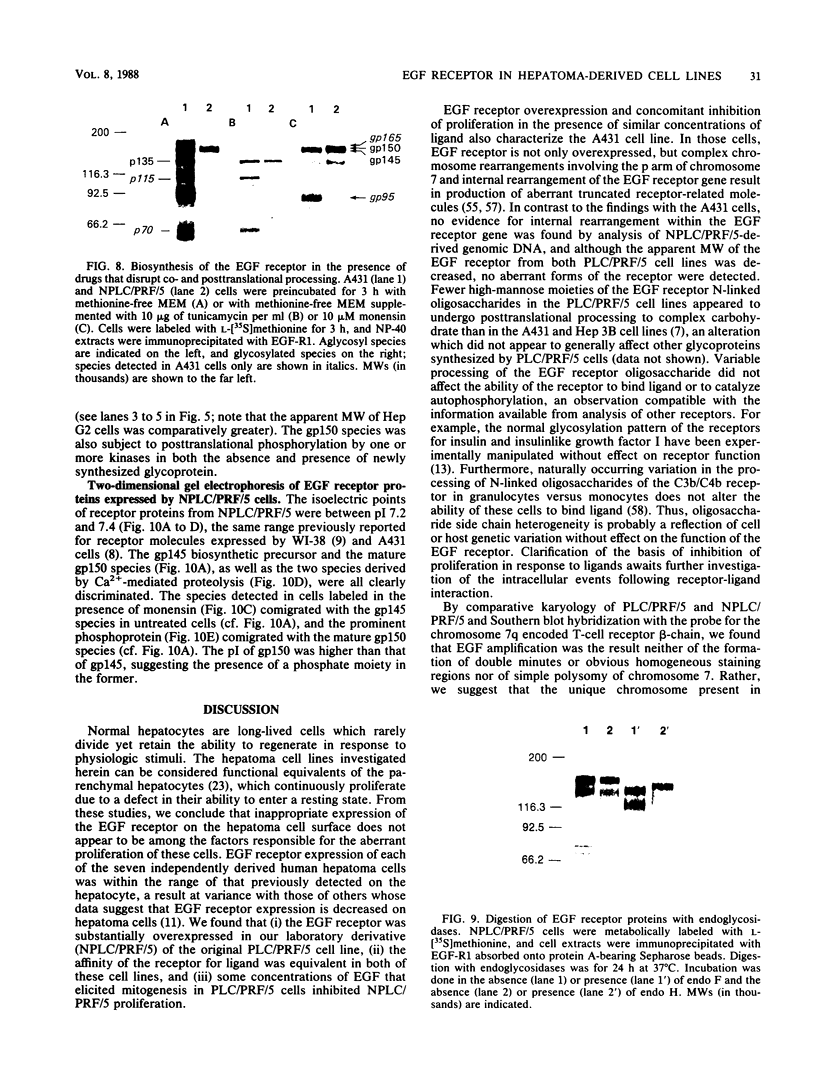
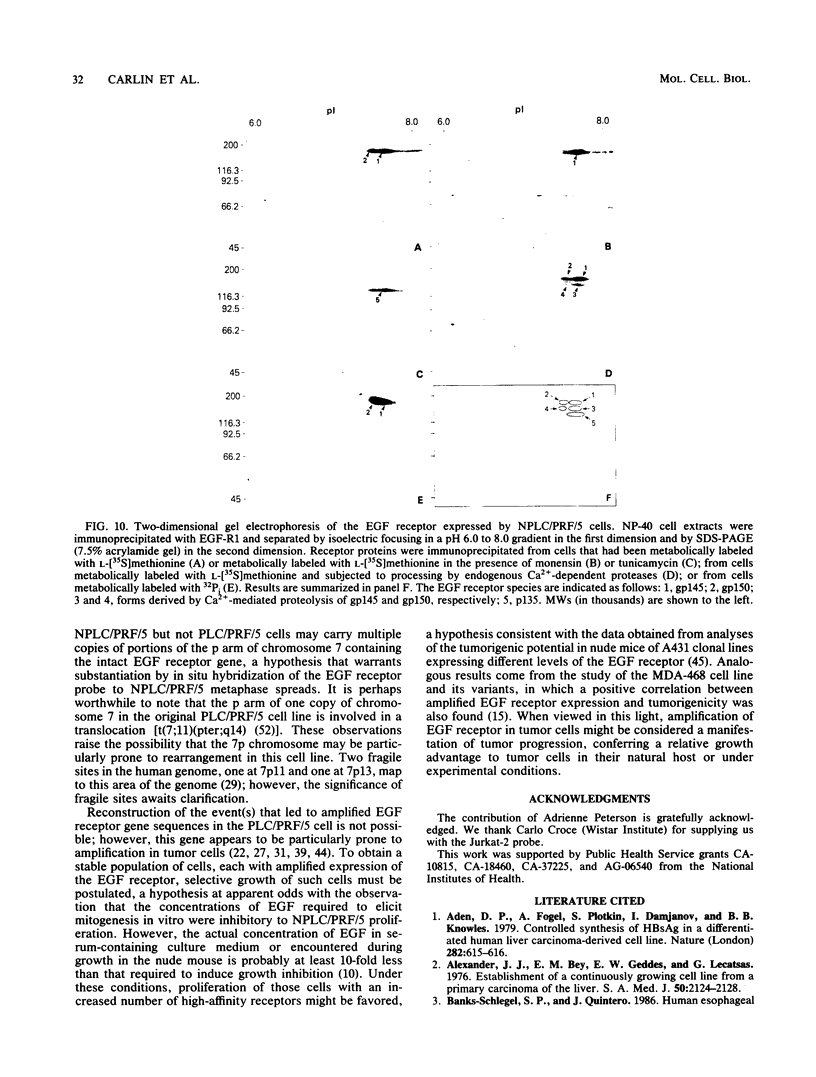
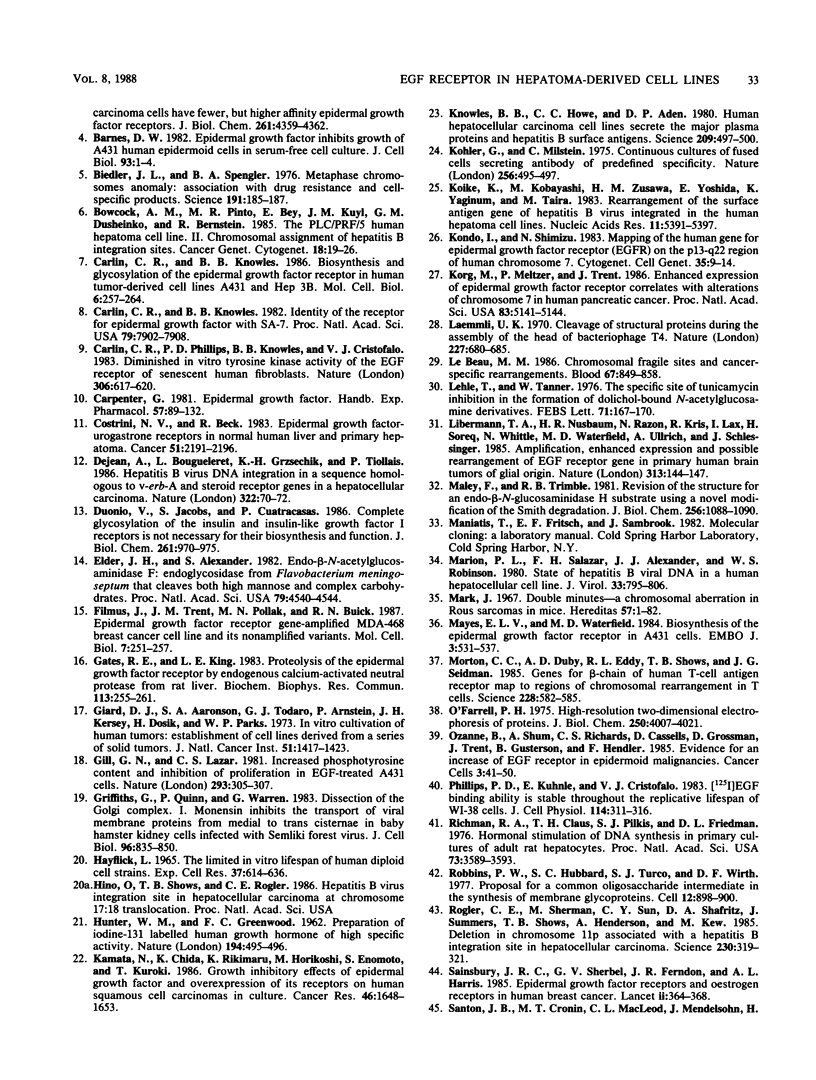
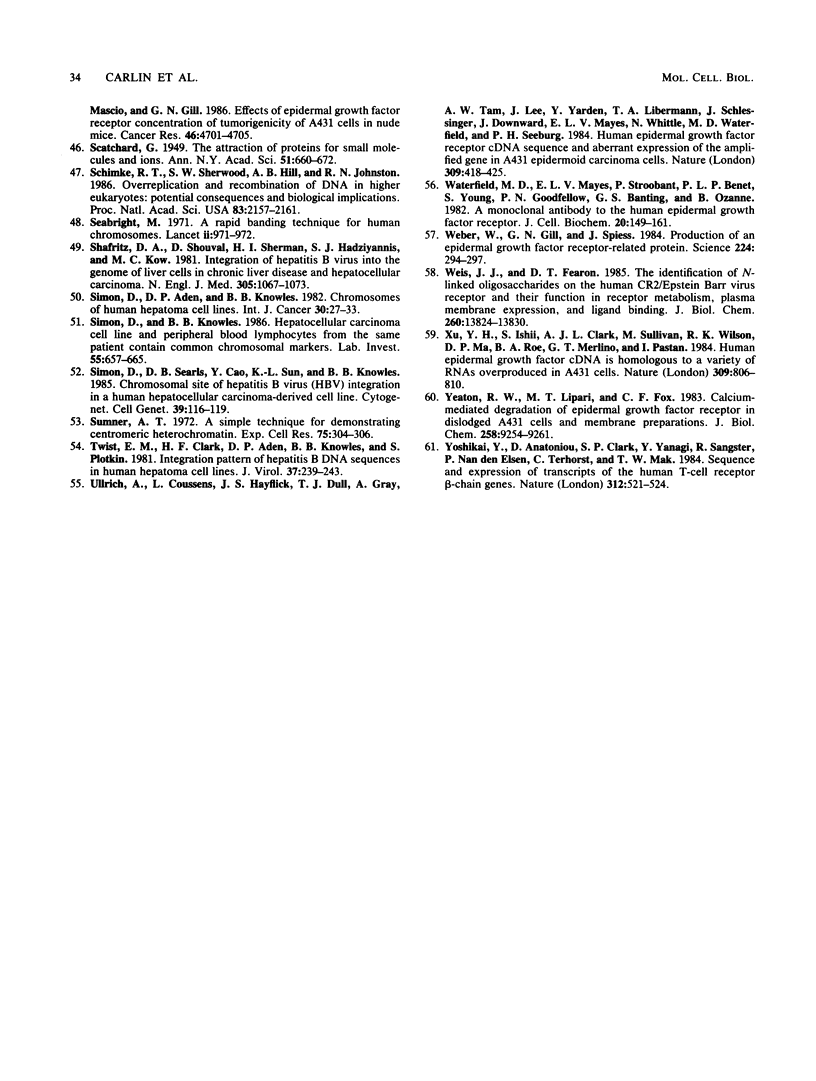
Images in this article
Selected References
These references are in PubMed. This may not be the complete list of references from this article.
- Aden D. P., Fogel A., Plotkin S., Damjanov I., Knowles B. B. Controlled synthesis of HBsAg in a differentiated human liver carcinoma-derived cell line. Nature. 1979 Dec 6;282(5739):615–616. doi: 10.1038/282615a0. [DOI] [PubMed] [Google Scholar]
- Alexander J. J., Bey E. M., Geddes E. W., Lecatsas G. Establishment of a continuously growing cell line from primary carcinoma of the liver. S Afr Med J. 1976 Dec 18;50(54):2124–2128. [PubMed] [Google Scholar]
- Banks-Schlegel S. P., Quintero J. Human esophageal carcinoma cells have fewer, but higher affinity epidermal growth factor receptors. J Biol Chem. 1986 Apr 5;261(10):4359–4362. [PubMed] [Google Scholar]
- Barnes D. W. Epidermal growth factor inhibits growth of A431 human epidermoid carcinoma in serum-free cell culture. J Cell Biol. 1982 Apr;93(1):1–4. doi: 10.1083/jcb.93.1.1. [DOI] [PMC free article] [PubMed] [Google Scholar]
- Biedler J. L., Spengler B. A. Metaphase chromosome anomaly: association with drug resistance and cell-specific products. Science. 1976 Jan 16;191(4223):185–187. doi: 10.1126/science.942798. [DOI] [PubMed] [Google Scholar]
- Bowcock A. M., Pinto M. R., Bey E., Kuyl J. M., Dusheiko G. M., Bernstein R. The PLC/PRF/5 human hepatoma cell line. II. Chromosomal assignment of hepatitis B virus integration sites. Cancer Genet Cytogenet. 1985 Sep;18(1):19–26. doi: 10.1016/0165-4608(85)90034-2. [DOI] [PubMed] [Google Scholar]
- Carlin C. R., Knowles B. B. Biosynthesis and glycosylation of the epidermal growth factor receptor in human tumor-derived cell lines A431 and Hep 3B. Mol Cell Biol. 1986 Jan;6(1):257–264. doi: 10.1128/mcb.6.1.257. [DOI] [PMC free article] [PubMed] [Google Scholar]
- Carlin C. R., Phillips P. D., Knowles B. B., Cristofalo V. J. Diminished in vitro tyrosine kinase activity of the EGF receptor of senescent human fibroblasts. Nature. 1983 Dec 8;306(5943):617–620. doi: 10.1038/306617a0. [DOI] [PubMed] [Google Scholar]
- Costrini N. V., Beck R. Epidermal growth factor-urogastrone receptors in normal human liver and primary hepatoma. Cancer. 1983 Jun 15;51(12):2191–2196. doi: 10.1002/1097-0142(19830615)51:12<2191::aid-cncr2820511207>3.0.co;2-q. [DOI] [PubMed] [Google Scholar]
- Dejean A., Bougueleret L., Grzeschik K. H., Tiollais P. Hepatitis B virus DNA integration in a sequence homologous to v-erb-A and steroid receptor genes in a hepatocellular carcinoma. Nature. 1986 Jul 3;322(6074):70–72. doi: 10.1038/322070a0. [DOI] [PubMed] [Google Scholar]
- Duronio V., Jacobs S., Cuatrecasas P. Complete glycosylation of the insulin and insulin-like growth factor I receptors is not necessary for their biosynthesis and function. Use of swainsonine as an inhibitor in IM-9 cells. J Biol Chem. 1986 Jan 15;261(2):970–975. [PubMed] [Google Scholar]
- Elder J. H., Alexander S. endo-beta-N-acetylglucosaminidase F: endoglycosidase from Flavobacterium meningosepticum that cleaves both high-mannose and complex glycoproteins. Proc Natl Acad Sci U S A. 1982 Aug;79(15):4540–4544. doi: 10.1073/pnas.79.15.4540. [DOI] [PMC free article] [PubMed] [Google Scholar]
- Filmus J., Trent J. M., Pollak M. N., Buick R. N. Epidermal growth factor receptor gene-amplified MDA-468 breast cancer cell line and its nonamplified variants. Mol Cell Biol. 1987 Jan;7(1):251–257. doi: 10.1128/mcb.7.1.251. [DOI] [PMC free article] [PubMed] [Google Scholar]
- Gates R. E., King L. E., Jr Proteolysis of the epidermal growth factor receptor by endogenous calcium-activated neutral protease from rat liver. Biochem Biophys Res Commun. 1983 May 31;113(1):255–261. doi: 10.1016/0006-291x(83)90459-x. [DOI] [PubMed] [Google Scholar]
- Giard D. J., Aaronson S. A., Todaro G. J., Arnstein P., Kersey J. H., Dosik H., Parks W. P. In vitro cultivation of human tumors: establishment of cell lines derived from a series of solid tumors. J Natl Cancer Inst. 1973 Nov;51(5):1417–1423. doi: 10.1093/jnci/51.5.1417. [DOI] [PubMed] [Google Scholar]
- Gill G. N., Lazar C. S. Increased phosphotyrosine content and inhibition of proliferation in EGF-treated A431 cells. Nature. 1981 Sep 24;293(5830):305–307. doi: 10.1038/293305a0. [DOI] [PubMed] [Google Scholar]
- Griffiths G., Quinn P., Warren G. Dissection of the Golgi complex. I. Monensin inhibits the transport of viral membrane proteins from medial to trans Golgi cisternae in baby hamster kidney cells infected with Semliki Forest virus. J Cell Biol. 1983 Mar;96(3):835–850. doi: 10.1083/jcb.96.3.835. [DOI] [PMC free article] [PubMed] [Google Scholar]
- HUNTER W. M., GREENWOOD F. C. Preparation of iodine-131 labelled human growth hormone of high specific activity. Nature. 1962 May 5;194:495–496. doi: 10.1038/194495a0. [DOI] [PubMed] [Google Scholar]
- Kamata N., Chida K., Rikimaru K., Horikoshi M., Enomoto S., Kuroki T. Growth-inhibitory effects of epidermal growth factor and overexpression of its receptors on human squamous cell carcinomas in culture. Cancer Res. 1986 Apr;46(4 Pt 1):1648–1653. [PubMed] [Google Scholar]
- Knowles B. B., Howe C. C., Aden D. P. Human hepatocellular carcinoma cell lines secrete the major plasma proteins and hepatitis B surface antigen. Science. 1980 Jul 25;209(4455):497–499. doi: 10.1126/science.6248960. [DOI] [PubMed] [Google Scholar]
- Koike K., Kobayashi M., Mizusawa H., Yoshida E., Yaginuma K., Taira M. Rearrangement of the surface antigen gene of hepatitis B virus integrated in the human hepatoma cell lines. Nucleic Acids Res. 1983 Aug 25;11(16):5391–5402. doi: 10.1093/nar/11.16.5391. [DOI] [PMC free article] [PubMed] [Google Scholar]
- Kondo I., Shimizu N. Mapping of the human gene for epidermal growth factor receptor (EGFR) on the p13 leads to q22 region of chromosome 7. Cytogenet Cell Genet. 1983;35(1):9–14. doi: 10.1159/000131829. [DOI] [PubMed] [Google Scholar]
- Korc M., Meltzer P., Trent J. Enhanced expression of epidermal growth factor receptor correlates with alterations of chromosome 7 in human pancreatic cancer. Proc Natl Acad Sci U S A. 1986 Jul;83(14):5141–5144. doi: 10.1073/pnas.83.14.5141. [DOI] [PMC free article] [PubMed] [Google Scholar]
- Köhler G., Milstein C. Continuous cultures of fused cells secreting antibody of predefined specificity. Nature. 1975 Aug 7;256(5517):495–497. doi: 10.1038/256495a0. [DOI] [PubMed] [Google Scholar]
- Laemmli U. K. Cleavage of structural proteins during the assembly of the head of bacteriophage T4. Nature. 1970 Aug 15;227(5259):680–685. doi: 10.1038/227680a0. [DOI] [PubMed] [Google Scholar]
- Le Beau M. M. Chromosomal fragile sites and cancer-specific rearrangements. Blood. 1986 Apr;67(4):849–858. [PubMed] [Google Scholar]
- Lehle L., Tanner W. The specific site of tunicamycin inhibition in the formation of dolichol-bound N-acetylglucosamine derivatives. FEBS Lett. 1976 Nov 15;72(1):167–170. doi: 10.1016/0014-5793(76)80922-2. [DOI] [PubMed] [Google Scholar]
- Libermann T. A., Nusbaum H. R., Razon N., Kris R., Lax I., Soreq H., Whittle N., Waterfield M. D., Ullrich A., Schlessinger J. Amplification, enhanced expression and possible rearrangement of EGF receptor gene in primary human brain tumours of glial origin. Nature. 1985 Jan 10;313(5998):144–147. doi: 10.1038/313144a0. [DOI] [PubMed] [Google Scholar]
- Maley F., Trimble R. B. Revision of the structure for an endo-beta-N-acetylglucosaminidase H substrate using a novel modification of the Smith degradation. J Biol Chem. 1981 Feb 10;256(3):1088–1090. [PubMed] [Google Scholar]
- Marion P. L., Salazar F. H., Alexander J. J., Robinson W. S. State of hepatitis B viral DNA in a human hepatoma cell line. J Virol. 1980 Feb;33(2):795–806. doi: 10.1128/jvi.33.2.795-806.1980. [DOI] [PMC free article] [PubMed] [Google Scholar]
- Mayes E. L., Waterfield M. D. Biosynthesis of the epidermal growth factor receptor in A431 cells. EMBO J. 1984 Mar;3(3):531–537. doi: 10.1002/j.1460-2075.1984.tb01842.x. [DOI] [PMC free article] [PubMed] [Google Scholar]
- Morton C. C., Duby A. D., Eddy R. L., Shows T. B., Seidman J. G. Genes for beta chain of human T-cell antigen receptor map to regions of chromosomal rearrangement in T cells. Science. 1985 May 3;228(4699):582–585. doi: 10.1126/science.3983642. [DOI] [PubMed] [Google Scholar]
- O'Farrell P. H. High resolution two-dimensional electrophoresis of proteins. J Biol Chem. 1975 May 25;250(10):4007–4021. [PMC free article] [PubMed] [Google Scholar]
- Phillips P. D., Kuhnle E., Cristofalo V. J. [125I]EGF binding ability is stable throughout the replicative life-span of WI-38 cells. J Cell Physiol. 1983 Mar;114(3):311–316. doi: 10.1002/jcp.1041140309. [DOI] [PubMed] [Google Scholar]
- Richman R. A., Claus T. H., Pilkis S. J., Friedman D. L. Hormonal stimulation of DNA synthesis in primary cultures of adult rat hepatocytes. Proc Natl Acad Sci U S A. 1976 Oct;73(10):3589–3593. doi: 10.1073/pnas.73.10.3589. [DOI] [PMC free article] [PubMed] [Google Scholar]
- Robbins P. W., Hubbard S. C., Turco S. J., Wirth D. F. Proposal for a common oligosaccharide intermediate in the synthesis of membrane glycoproteins. Cell. 1977 Dec;12(4):893–900. doi: 10.1016/0092-8674(77)90153-2. [DOI] [PubMed] [Google Scholar]
- Rogler C. E., Sherman M., Su C. Y., Shafritz D. A., Summers J., Shows T. B., Henderson A., Kew M. Deletion in chromosome 11p associated with a hepatitis B integration site in hepatocellular carcinoma. Science. 1985 Oct 18;230(4723):319–322. doi: 10.1126/science.2996131. [DOI] [PubMed] [Google Scholar]
- Sainsbury J. R., Farndon J. R., Sherbet G. V., Harris A. L. Epidermal-growth-factor receptors and oestrogen receptors in human breast cancer. Lancet. 1985 Feb 16;1(8425):364–366. doi: 10.1016/s0140-6736(85)91385-6. [DOI] [PubMed] [Google Scholar]
- Santon J. B., Cronin M. T., MacLeod C. L., Mendelsohn J., Masui H., Gill G. N. Effects of epidermal growth factor receptor concentration on tumorigenicity of A431 cells in nude mice. Cancer Res. 1986 Sep;46(9):4701–4705. [PubMed] [Google Scholar]
- Schimke R. T., Sherwood S. W., Hill A. B., Johnston R. N. Overreplication and recombination of DNA in higher eukaryotes: potential consequences and biological implications. Proc Natl Acad Sci U S A. 1986 Apr;83(7):2157–2161. doi: 10.1073/pnas.83.7.2157. [DOI] [PMC free article] [PubMed] [Google Scholar]
- Seabright M. A rapid banding technique for human chromosomes. Lancet. 1971 Oct 30;2(7731):971–972. doi: 10.1016/s0140-6736(71)90287-x. [DOI] [PubMed] [Google Scholar]
- Shafritz D. A., Shouval D., Sherman H. I., Hadziyannis S. J., Kew M. C. Integration of hepatitis B virus DNA into the genome of liver cells in chronic liver disease and hepatocellular carcinoma. Studies in percutaneous liver biopsies and post-mortem tissue specimens. N Engl J Med. 1981 Oct 29;305(18):1067–1073. doi: 10.1056/NEJM198110293051807. [DOI] [PubMed] [Google Scholar]
- Simon D., Aden D. P., Knowles B. B. Chromosomes of human hepatoma cell lines. Int J Cancer. 1982 Jul 15;30(1):27–33. doi: 10.1002/ijc.2910300106. [DOI] [PubMed] [Google Scholar]
- Simon D., Knowles B. B. Hepatocellular carcinoma cell line and peripheral blood lymphocytes from the same patient contain common chromosomal alterations. Lab Invest. 1986 Dec;55(6):657–665. [PubMed] [Google Scholar]
- Simon D., Searls D. B., Cao Y., Sun K., Knowles B. B. Chromosomal site of hepatitis B virus (HBV) integration in a human hepatocellular carcinoma-derived cell line. Cytogenet Cell Genet. 1985;39(2):116–120. doi: 10.1159/000132118. [DOI] [PubMed] [Google Scholar]
- Sumner A. T. A simple technique for demonstrating centromeric heterochromatin. Exp Cell Res. 1972 Nov;75(1):304–306. doi: 10.1016/0014-4827(72)90558-7. [DOI] [PubMed] [Google Scholar]
- Twist E. M., Clark H. F., Aden D. P., Knowles B. B., Plotkin S. A. Integration pattern of hepatitis B virus DNA sequences in human hepatoma cell lines. J Virol. 1981 Jan;37(1):239–243. doi: 10.1128/jvi.37.1.239-243.1981. [DOI] [PMC free article] [PubMed] [Google Scholar]
- Ullrich A., Coussens L., Hayflick J. S., Dull T. J., Gray A., Tam A. W., Lee J., Yarden Y., Libermann T. A., Schlessinger J. Human epidermal growth factor receptor cDNA sequence and aberrant expression of the amplified gene in A431 epidermoid carcinoma cells. 1984 May 31-Jun 6Nature. 309(5967):418–425. doi: 10.1038/309418a0. [DOI] [PubMed] [Google Scholar]
- Waterfield M. D., Mayes E. L., Stroobant P., Bennet P. L., Young S., Goodfellow P. N., Banting G. S., Ozanne B. A monoclonal antibody to the human epidermal growth factor receptor. J Cell Biochem. 1982;20(2):149–161. doi: 10.1002/jcb.240200207. [DOI] [PubMed] [Google Scholar]
- Weber W., Gill G. N., Spiess J. Production of an epidermal growth factor receptor-related protein. Science. 1984 Apr 20;224(4646):294–297. doi: 10.1126/science.6324343. [DOI] [PubMed] [Google Scholar]
- Weis J. J., Fearon D. T. The identification of N-linked oligosaccharides on the human CR2/Epstein-Barr virus receptor and their function in receptor metabolism, plasma membrane expression, and ligand binding. J Biol Chem. 1985 Nov 5;260(25):13824–13830. [PubMed] [Google Scholar]
- Xu Y. H., Ishii S., Clark A. J., Sullivan M., Wilson R. K., Ma D. P., Roe B. A., Merlino G. T., Pastan I. Human epidermal growth factor receptor cDNA is homologous to a variety of RNAs overproduced in A431 carcinoma cells. 1984 Jun 28-Jul 4Nature. 309(5971):806–810. doi: 10.1038/309806a0. [DOI] [PubMed] [Google Scholar]
- Yeaton R. W., Lipari M. T., Fox C. F. Calcium-mediated degradation of epidermal growth factor receptor in dislodged A431 cells and membrane preparations. J Biol Chem. 1983 Aug 10;258(15):9254–9261. [PubMed] [Google Scholar]
- Yoshikai Y., Anatoniou D., Clark S. P., Yanagi Y., Sangster R., Van den Elsen P., Terhorst C., Mak T. W. Sequence and expression of transcripts of the human T-cell receptor beta-chain genes. Nature. 1984 Dec 6;312(5994):521–524. doi: 10.1038/312521a0. [DOI] [PubMed] [Google Scholar]





